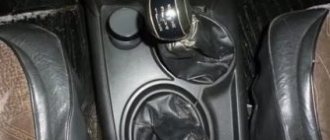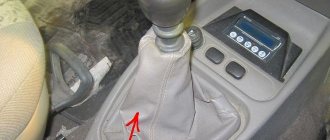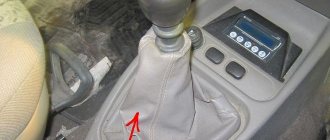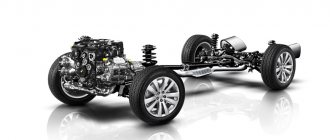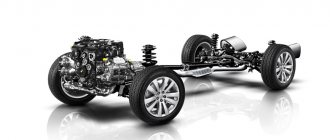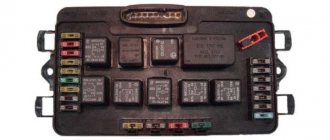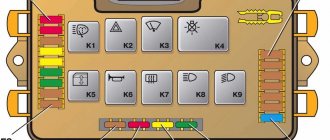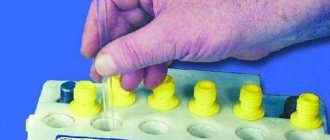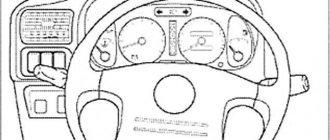The situation when reverse gear does not engage on a VAZ 2109 is one of the most common problems with this car model. In addition, the VAZ 2108/09/099 “Samara” and VAZ 2113/14/15 “Samara-2” cars were equipped with the same type of gearbox (gearbox), so this transmission malfunction is typical not only for “Nines”.
Often, an attempt to engage a gear is accompanied by a strong crunch of gears, and if the gear is able to be engaged, the gearbox makes noise when moving in reverse. Other owners are faced with a situation where the gear shift lever moves forward all the way, but reverse gear does not work. At the same time, there are no complaints about shifting forward gears.
Changing the gearbox oil
Replacing the gear selection mechanism
Comments and Reviews
Repair or replacement
If, during checking the condition of the box, serious damage to its elements was revealed, then serious repairs cannot be avoided.
It should be immediately noted that independent dismantling, repair and reassembly of a gearbox requires not only very good equipment (nominally a pit or overpass, a lifting device, as well as a large set of tools are required), but also very serious knowledge.
That is why, if the gears of a VAZ 2114 do not engage, such repairs should be entrusted to specialists from car service centers.
It should be remembered that independent repair or replacement of the gearbox automatically leads to the loss of all warranty obligations from the manufacturer. For this reason, repairs to a car that is under warranty should be entrusted to branded repair shops.
If we talk about the choice between repair and complete replacement of the unit, then in most cases you should choose the first option. This is due to two reasons. Firstly, the cost of a completely new box exceeds 15 thousand rubles. (moreover, this amount is indicated without taking into account the cost of its installation). In any case, repairs will be much cheaper. And secondly, complete wear of the box (to a state unsuitable for repair) is extremely rare.
The cost of the repair work itself varies from service to service and depends on:
- the size of the locality (and, as a consequence, the presence of competitors);
- type of breakdown;
- the size of the car service (and whether it is official);
- additional clauses in the terms of the contract.
How to repair a VAZ 2109 gearbox?
How to find a fault in the gearbox of a VAZ 2109
Special cases
Second gear is not detected.
When you start the car, noise comes from the gearbox and you hear crunching noises.
- the fifth gear or reverse gear has failed;
- The release bearing or the input shaft bearing is faulty.
Any transmission fails.
When driving at 9, there is a hum, when I press the clutch the hum does not stop. What's humming, bearings?
Hello everyone, help me, on 09, speed 2 stuck and won’t let go, what should I do? but we already sorted it out, now it’s set to 3 speed again, what should I do?
Possibly a bearing. Soon he’s still walking freely along the shaft. The shaft must be together with the internal part of the bearing. spin, and he rotates freely in it. It is also likely that this is the reason for the rumble.
I have a similar situation. I went through the box twice. I changed all the bearings, but the noise never went away. I'm already starting to get used to it.
The situation is exactly like this, it’s like my car in the video. Most likely you need to make a mistake in 5th gear, the only question is how to check. But one idea has appeared, you can remove the 5th gear cover, open two nuts, remove the 5th gear gears, close the cover, add oil, and then everything will be clear. I’m thinking about doing this one of these days. Report the results.
Replacement box - new or old?
If the reason why the gears on the VAZ 2114 are poorly engaged is due to very severe wear of the gearbox components, and it turns out that its repair will be more expensive than a complete replacement, then the motorist is faced with a choice - install a new gearbox or give preference to a “restored” one.
The first option is certainly preferable, but the fact is that a new gearbox is not cheap at all (as mentioned above).
The cost of a refurbished one is much less (sometimes such a box costs 70% less than a new one).
A rebuilt gearbox is an excellent option, which is almost in no way inferior in quality to a new gearbox, but at the same time costs much less. The only thing to remember is that such units should only be purchased from trusted companies that professionally restore them and provide a guarantee for their products.
It should also be remembered that if there is a choice, it is better to give preference to the “middle option”. You should absolutely not purchase refurbished boxes from little-known companies at a very low price.
Re: Noise in manual transmission in neutral
I read somewhere on a forum: Quote: “What I like about our forum is that you never get an answer.”
Let me pose the question differently - what could possibly be humming in the box in neutral, but the hum goes away under load? It’s clear that it’s the bearings, or maybe something else? I would like to perform an autopsy already having all the spare parts on hand, because... Our officials have prices for spare parts that differ from existential prices by 2-3 times))). It’s cheaper to buy EVERYTHING at the existential store in advance than what you need from the officials after opening it.
Advice for motorists
Above we have already talked about why the reverse gear on the VAZ 2114 does not engage and how to correct this situation. But it should also be noted that proper and timely care of the gearbox will help either completely avoid such a situation or postpone it for as long as possible.
There are only two basic rules for this care:
- Change gears, as well as accelerate and brake the vehicle as smoothly as possible, without jerking.
- Periodically check the oil level, replenish it as it is used, and also replace the entire volume if it is worn out.
These simple rules will help to significantly increase the service life of the entire box and its individual parts.
The reverse gear of the VAZ 2114 stopped engaging - video
Not so long ago, reverse gear began to engage with a crunch, and then disappeared completely! In the video I explained everything briefly and clearly! The same goes for owners of 08/09/10/11/12/13/14/15 models Lada, Kalina, Priora, Grant here too) The reasons were told on the YouTube channel:
Typical breakdowns
General form
Based on some signs, it can be determined that certain gearbox components on a VAZ 2114 need to be repaired.
- When a certain gear is engaged, it does not lock properly and crashes. This indicates that the fastenings of the gear teeth and clutch are worn out. When reverse gear is difficult to engage on a VAZ 2114, you will have to take certain measures. Repair consists of replacing the damaged element. If the gear engages spontaneously, the reason may also lie in wear, delamination and cracking on the rubber element of the rear support. Just replace it.
- To engage the gear you have to apply more force than usual. If the reverse gear on a VAZ 2114 car does not engage, the problem is most likely hidden in loose or worn teeth attaching to the hinge. This may also occur due to deformation of the torque rod or the appearance of cracks in the plastic part of the gearbox drive.
- There is noise in neutral gear. The oil level may be too low or its original viscosity may have been lost. Plus, a similar symptom is characteristic of wear on the upper bearing of the input shaft. Check this element, inspect the oil level and quality.
- It is not uncommon for reverse gear to engage with a crunch on a VAZ 2114. The problem here is the wear of the synchronizer. If the problem is not corrected at the first sign of its occurrence, this may result in the need to replace the entire gear assembly and synchronizer.
- Noise is generated while the car is moving in certain gears. A similar malfunction occurs due to a damaged lower or upper bearing. Along with the noise, the lever may jam. The only option is to carry out a full diagnosis of the gearbox.
- A knocking noise occurs in a certain gear with or without load. The problem lies in the drive gear, which will have to be replaced.
- When the transmission is engaged, a cracking sound is heard. This indicates wear of the synchronizer blocking ring or the need to replace the satellite axle. The box will have to be sorted out to fix the damage.
- Oil leaks from the box. The reasons can be very diverse, so you will have to carefully diagnose the checkpoint.
Why reverse gear does not engage - common reasons
In this article we will look at the main reasons:
Speed switch
- The first thing you need to pay attention to is the rocker itself and the cardan - it often happens that the rocker slips, the splines are ground off or the clamp is loose. In this case, you will need an overpass or a pit.
- Reverse gear locking mechanism. To check this mechanism, you need to remove the gearshift knob (the dashboard between the seats) and look. Everything will become clear.
- If you checked the first two points and found no problems, then you will have to remove the gearbox.
- The fixing bolt was cut off.
- Fastening the gear selection mechanism.
- A spring (the most common one sometimes bursts).
Alternatively, the reason may be in the release bearing, but then all gears would be engaged barely and with a crunch. You can also try adjusting the clutch pedal.
Re: Noise in manual transmission in neutral
For me, it’s exactly the opposite, the buzzing happens exactly when I’m coasting, as soon as you put it in gear and give it a little load, the hum goes away. Moreover, the hum occurs if the speed is in the range from 40 to 90 km/h. At lower and higher levels there is silence. I decided to drive up to 40,000 km and for an autopsy. I'll write about the results.
In general, we finally got our hands on the box. Or rather, I decided to change the clutch to a softer one and at the same time deal with the gearbox. The mileage as of today is 56,000, the hum is still the same (no more, no less current without load in neutral). I suspect that you can hammer it and drive until the end of time, but I want to fix it. Sentence: replace the differential gear 41221-20400 and where this gear is inserted, the actual output shaft 33302-20030. The cost of new spare parts is 10 rubles. Repairs are probably the same. Now the question is – should I bother or buy a used box and install it? Price range for used Manual transmission from 10-20 rubles in Moscow to 48. (hehe) in Krasnodar. I think it’s my own family there, except for this hum, everything is super, but it’s a pig in a poke to buy.
Extending the service life of gearboxes
You will be able to use your car for many years without going to car repair shops if you can follow basic recommendations. They will extend the service life of the gearbox, minimize possible problems, breakdowns and the need for repair work.
There are only two recommendations.
- Always try to monitor the oil level in the gearbox. If it drops, be sure to top it up immediately, do not delay the procedure until later. When the oil becomes unusable, change it completely, rather than fill in the missing amount.
- Avoid aggressive use, do not jerk the gears sharply, accelerate smoothly, and brake similarly. A simple caring attitude towards the gearbox will allow you to avoid wear and tear and numerous breakdowns.
As you can see, solving problems with checkpoints is not so easy. Therefore, the best option is to prevent their occurrence.
Eliminating noise
Let's look at the signs and corresponding breakdowns of the gearbox in the VAZ 2109
| Signs |
Replacing the drive shaft bearing
If you decide to repair the drive shaft bearing yourself, then for this you will need a hammer, a vice, and a bearing puller. Let's start the repair:
- First you need to dismantle and disassemble your gearbox;
- then we take the drive shaft and clamp it in a vice. Attention! The vice must have soft metal pads;
- the rear bearing must be pressed using a special puller;
- then turn the shaft over and compress the inner race of the primary bearing in the same way;
- Now you need to push the rear bearing all the way onto the shaft. This is done using a metal mandrel and a hammer;
- the same operation must be done with the inner ring of the front bearing.
Add oil
If you decide to fix the noise problem by adding transmission fluid to the box, then prepare new manual transmission oil and some rags in advance:
- we find the dipstick for monitoring the fluid level in the box - it is located in the engine compartment on the left side, next to the battery;
- take out the dipstick and wipe it with a rag;
- then insert the dipstick back all the way and pull it out. The transmission fluid level should be somewhere between o and “Max”;
- if you see that there is less oil than necessary, then take a new one and fill it through the hole to check the level to o.
Replacing locking rings
To replace the rings of the locking mechanism, perform the following steps:
- remove and disassemble the gearbox;
- we find the blocking device;
- We see blocking synchronizers on it: you need to visually assess their condition. If fragments are visible on the rings or they themselves have expired their service life, then they need to be replaced;
- We put the box back together and put it in place.
If the hum in the manual transmission appears as a result of wear on the rings, then when they are replaced, the extraneous sounds will disappear.
Replacing the synchronizer clutch
Here you need to stock up on clutch and patience in advance:
- Having disassembled the gearbox, you need to remove the secondary shaft synchronizer;
- To get to the clutch, the synchronizer must be completely disassembled. Be careful - the parts are very small and can be easily lost. The clutch is a small ring on the inner diameter of the synchronizer;
- Having disassembled the synchronizer, check all its components for mechanical damage. If the springs are too stretched, then it is also better to replace them with new ones, but you need to buy a complete repair kit in advance;
- before installing the clutch in place, lubricate it, as well as all other synchronizer components, with engine oil;
Clutch adjustment
Incomplete disengagement of the clutch is “treated” by adjusting it:
- The clutch pedal must be pressed to the floor all the way and a meter or ruler should be placed next to it, one end of which should also be rested on the floor. Then you need to fix the value at the center of the pedal;
- now release the pedal and in the uppermost position mark the number of centimeters to it from the floor;
- then slowly press the pedal with your hand and mark the place where the clutch begins to provide resistance for further pressing;
- the amount of free play is the same distance from the pedal position until the moment the clutch begins to exert resistance;
- Now open the hood and look for the cable that connects to the pedal. There are two nuts on it, with the help of which adjustment is carried out;
Adjusting the clutch pedal cable
For those with automatic
If your car has an automatic transmission. It will not hurt you to know the modes in which your machine can operate:
- P – For parking and starting the engine. Switching to this mode is possible only after the machine has completely stopped.
- R – To move backwards. Switching to this mode is also possible only after stopping the car and with the brake pedal pressed.
- N – Neutral. When the engine is completely disconnected from the gearbox.
- D – Moving forward without restrictions on gear shifting (the most commonly used operating mode of the automatic transmission).
- D3(S) – Low gears for climbing and braking engines on descents.
- D2 – Mode for difficult conditions (slippery or mountainous roads). Gears above second are not shifted, that is, only first and second gears are engaged.
- D1(L) - Movement occurs only in 1st gear, used off-road on mud, snow or ice, where you need to drive without changing the throttle, and also to overcome steep climbs.
The automatic transmission also has a button on the mode shift lever with the inscription O/D OFF. When it is turned on, the inclusion is prohibited, increasing the gears of the analogue of the 5th gear of the manual transmission. That is, if your automatic machine has 4 gears for moving forward, then for more dynamic acceleration it will use only three lower gears.
About a faulty automatic transmission, an automatic transmission is much more complex than those encountered with a manual transmission, and the chances of repairing it in your garage are slim. But despite this, you still need to know something about it, if only in order not to harm it through improper use.
An automatic transmission is much more demanding in terms of accuracy in maintaining the oil level in it than a manual transmission. Both too low and too high oil levels are very harmful to her. Both of these can lead to serious damage. In both cases, oil foaming occurs. When there is a lack of oil due to the fact that the oil pump begins to capture air along with the oil. When there is excess oil, it foams on the rotating parts, which in this case are immersed in it. Foamed oil compresses better and has low thermal conductivity. Therefore, if you operate a machine with such oil, the pressure in its control systems will be low. Which will lead to slipping of the clutches and their intensive wear. Deteriorated thermal conductivity will not allow all excess heat to be removed. Which, together with low pressure, will lead to the machine failing and requiring serious repairs.

